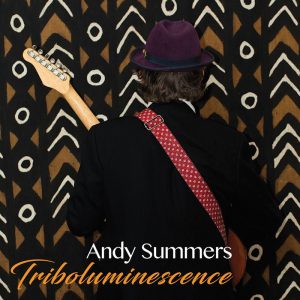Written by James Killen
 Andy Summers rose to fame in the seventies and eighties as the lead guitar player for The Police, backing up Sting and creating the new wave/jazz/ reggae sound that took the airwaves by storm. He has been putting out solo albums since the band broke up and is now releasing his latest, “Triboluminescence”, which means creating light from darkness.
Andy Summers rose to fame in the seventies and eighties as the lead guitar player for The Police, backing up Sting and creating the new wave/jazz/ reggae sound that took the airwaves by storm. He has been putting out solo albums since the band broke up and is now releasing his latest, “Triboluminescence”, which means creating light from darkness.
Police fans might be a little taken aback as this record leaves the rock idiom behind and is a full on jazz fusion effort. Summers exploits guitar tape loops for rhythm, depth and texture in these numbers. He starts the disc with “If Anything” using slow sustain guitar strokes over an electronic keyboard fill. He follows that with the title track using a meandering guitar melody that gradually approaches climax over an almost clockwork rhythm, settling into a mellow fuzz guitar conclusion.
The third track, “Adinkra”, features a complex Middle Eastern guitar melody over a West African rhythm, further thickened by a muted trumpet background and guitar harmonics. “Elephant Bird” is built on looping guitar leads with distorted guitar tones that sound almost like muted trumpets and smooth note transitions laid over a rhythm that walks like a parade of elephants.
One of my favorite ditties is “Shadyland” which is a haunting jazz line with an East Asian melody that moves into a nightscape of simulated crickets and frogs with reed pipes in the background and then allows the Asian melody to reemerge for the conclusion of the piece. “Haunted Dolls” begins with a looped guitar over a steady snare drum beat, from which emerges a jazzy guitar lead that builds to a crescendo and then stutters back to the looped guitar.
 Another of my favorites is “Gigantopithicus” which is a basic rhythm of electronic drums with a smooth saxophone and muted trumpet background. The guitar part almost hides behind the rhythm and then slips out for a brief lead and then back behind the rhythm again and again.
Another of my favorites is “Gigantopithicus” which is a basic rhythm of electronic drums with a smooth saxophone and muted trumpet background. The guitar part almost hides behind the rhythm and then slips out for a brief lead and then back behind the rhythm again and again.
“Pukul Buny Bunye” is Indonesian for hammering. Summers says that he set up the rhythm with two guitars at different tunings, played them by striking the strings with chop sticks and then played a Stratocaster lead over the top of it. He follows that with “Garden of the Seas” in which he creates a bubbly background of reversed guitar loops and applies a cello melody for a mellow conclusion to this most interesting effort.
This disc will not satisfy someone looking for a Police nostalgia record, but it will appeal to jazz fusion fans and guitar technology aficionados. The tunes are multilayered and deserve several listens to get the full trippy effect.

Sounds like a neat cd.